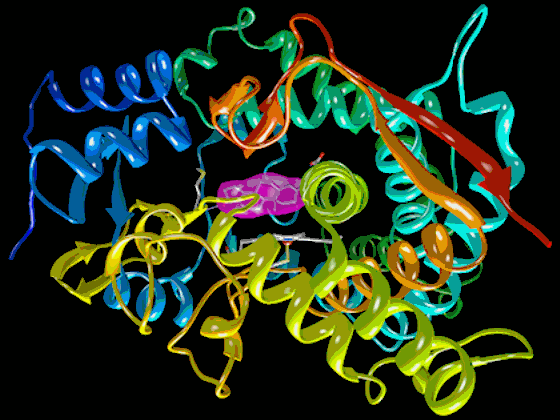Like watchmakers prying open a complicated timepiece, researchers at Roswell Park Cancer Institute (RPCI) and Hauptman-Woodward Institute (HWI) are using x-ray beams from the U.S. Department of Energy’s Advanced Photon Source (APS), and the Cornell High Energy Synchrotron Source (CHESS), to peer into the molecular works of an enzyme that has long defied investigation. What they are discovering may one day make it possible to design safer, more effective cancer-fighting drugs.
The enzyme in question is called “aromatase.” Understanding aromatase is critical to breast-cancer research because it produces estrogen, the hormone responsible for the development and function of female sexual characteristics.
Unfortunately, estrogen also encourages the growth of “hormone-dependent” breast cancers. Drugs that stop aromatase from producing estrogen — aromatase inhibitors, or AIs — have been frontline therapies against hormone-dependent cancers for decades. Commercial AIs include Femara, Aromidex, and Aromasin.
But although aromatase has been studied for almost 40 years, its estrogen-producing process has remained poorly understood.
Now, in the journal Nature, RPCI and HWI researchers report that they have been able to examine the mechanism of aromatase action at the molecular level.
Among the team’s key innovations was a method for crystallizing a pure form of the enzyme, which is derived from donated human placentas. Aromatase is the only protein of its type—a natural microsomal cytochrome P450 enzyme—ever to be crystallized by this approach.
Extracting, purifying, and stabilizing pure aromatase was a long-sought goal. The researchers perfected their method over a span of 12 years. Ordinarily, recombinant DNA technology enables the production of human enzymes and proteins in bacteria and other cells. That approach has proved to be extremely difficult for aromatase, which degrades very rapidly. Researchers all over the world spent decades trying to crystallize aromatase from bacteria, without success. But fresh human placenta, as it turns out, is a rich source of pristine, fully functional aromatase.
After homing in on the placental approach, the team had to develop a battery of new techniques for enzyme capture and purification. Securing the purified enzyme was only step one. The team gathered data for a high-resolution atomic model of aromatase by examining crystals with x-rays from the Structural Biology Center x-ray beamline 19-ID at the Argonne APS, and the A-1 station of CHESS at Cornell University. The completed digital model depicts an intricate, exquisitely tuned molecular machine for manufacturing estrogen.
The group feels that the technology they have developed will help them to understand how aromatase inhibitors prevent the enzyme from making estrogens, and then to design, synthesize, and test a next generation of AIs—highly specific for aromatase, but with minimal side effects.
Contact: D. Ghosh, ghosh@hwi.buffalo.edu
See: Debashis Ghosh, Jennifer Griswold, Mary Erman, and Walter Pangborn, “Structural basis for androgen specificity and oestrogen synthesis in human aromatase,” Nature 457, 219 (8 January 2009). DOI:10.1038/nature07614
This research was the subject of a Nature News and Views article entitled “Structural biology: Anticancer drug target pictured,” by Michael R. Waterman (Department of Biochemistry, Vanderbilt University School of Medicine). “Not only is the aromatase enzyme implicated in a common form of breast cancer, but it also catalyses an unusual biochemical reaction. Its crystal structure therefore offers both practical and fundamental insights.”
The original press release can be found here.
The research is supported in part by grants GM62794 and GM59450 (to D.G.) from the National Institutes of Health. Use of the Advanced Photon Source at Argonne National Laboratory was supported by the U. S. Department of Energy, Office of Science, Office of Basic Energy Sciences, under Contract No. DE-AC02-06CH11357.
Argonne National Laboratory seeks solutions to pressing national problems in science and technology. The nation's first national laboratory, Argonne conducts leading-edge basic and applied scientific research in virtually every scientific discipline. Argonne researchers work closely with researchers from hundreds of companies, universities, and federal, state and municipal agencies to help them solve their specific problems, advance America 's scientific leadership and prepare the nation for a better future. With employees from more than 60 nations, Argonne is managed by UChicago Argonne, LLC for the U.S. Department of Energy's Office of Science.

